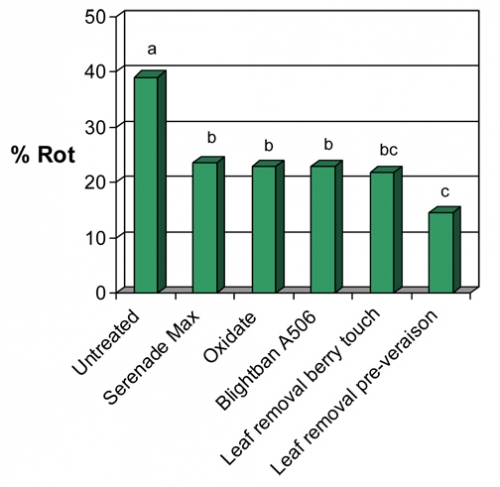Fall rains bring bunch rot pains
Editor’s note: This article is from the archives of the MSU Crop Advisory Team Alerts. Check the label of any pesticide referenced to ensure your use is included.
As cool, wet weather approaches in the fall, berries of tight-clustered grape varieties may succumb to Botrytis bunch rot caused by the fungus Botrytis cinerea or to sour rot, which is caused by acetic acid bacteria and yeasts. Berries affected by Botrytis develop a gray mold on them, while sour rot causes clusters to smell distinctly of vinegar. Fruit flies are often present in sour rot clusters and help spread the disease. Damage can be extensive because infections that begin in a single berry can rapidly spread to adjacent berries and destroy most or all of a cluster. Injury to the berry, either by rain splitting, separation from stem due to internal pressures in tight clusters, hail, powdery mildew infection, or insect or bird feeding can all allow sour rot organisms to enter the berry. Even inconspicuous powdery mildew colonies resulting from late-season infections can increase the severity of bunch rot.
Improving air circulation and reducing humidity in the canopy can help control Botrytis bunch rot as well as sour rot. This can be done by leaf removal in the fruit zone, shoot positioning, shoot thinning and hedging. While there are few options for control of sour rot, Botrytis bunch rot can be managed with the fungicides Vangard, Scala, Endura and Elevate. Efficacy of the older fungicide Rovral is improved by adding a spray adjuvant. If Pristine is used for Botrytis, it has to be applied at the higher labeled rate (18.5-23 oz) to be effective. The best spray timings to protect the fruit are bunch closure, veraison, and pre-harvest. Alternating fungicides in different chemical groups is advised. Figure 1 shows the benefits of leaf removal and fungicides (applied five times from bloom until pre-harvest) for control of the Botrytis bunch rot/sour rot complex in a small plot trial in Vignoles in 2008.
Figure 1. Efficacy of various fungicides and leaf removal treatments in managing bunch rots (Botrytis and sour rot) in Vignoles grapes in 2008.

Serenade Max = Bacillus subtilis bacteria (applied with NuFilm adjuvant)
Oxidate = hydrogen peroxide
Blightban A506 = Pseudomonas fluorescens bacteria.
Dr. Schilder's work is funded in part by MSU's AgBioResearch.



 Print
Print Email
Email



